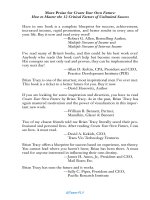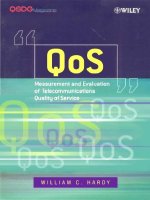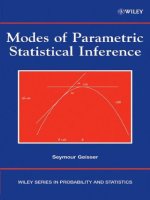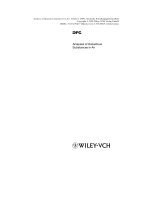John wiley sons chromatography analysis of hazardous substances in air vol 5 2002
Bạn đang xem bản rút gọn của tài liệu. Xem và tải ngay bản đầy đủ của tài liệu tại đây (1.56 MB, 234 trang )
Analyses of Hazardous Substances in Air, Volume 5. DFG, Deutsche Forschungsgemeinschaft
Copyright c 2002 Wiley-VCH Verlag GmbH
ISBNs: 3-527-27046-9 (Hardcover); 3-527-60019-1 (Electronic)
Analyses of Hazardous
Substances in Air
Analyses of Hazardous Substances in Air, Volume 5. DFG, Deutsche Forschungsgemeinschaft
Copyright c 2002 Wiley-VCH Verlag GmbH
ISBNs: 3-527-27046-9 (Hardcover); 3-527-60019-1 (Electronic)
Deutsche Forschungsgemeinschaft
Analyses of Hazardous
Substances in Air
Volume 5
edited by Antonius Kettrup
Working Group Analytical Chemistry
Commission for the Investigation of Health
Hazards of Chemical Compounds in the
Work Area
(Chairman: Helmut Greim)
Analyses of Hazardous Substances in Air,Volume 5. DFG, Deutsche Forschungsgemeinschaft
Copyright # 2002 Wiley-VCH Verlag GmbH
ISBNs: 3-527-27046-9 (Hardcover); 3-527-60019-1 (Electronic)
Prof. Dr. med. Helmut Greim
Senatskommission
zur Prçfung gesundheitsschådlicher Arbeitsstoffe
der Deutschen Forschungsgemeinschaft
Technische Universitåt Mçnchen
Hohenbachernstr. 15±17
D-85354 Freising-Weihenstephan
Prof. Dr. rer. nat. Dr. h. c. Antonius Kettrup
GSF-Forschungszentrum fçr Umwelt und Gesundheit
Institut fçr Úkologische Chemie
Ingolstådter Landstraûe 1
D-85764 Neuherberg
Translators: Julia Handwerker-Sharman,
Dr. Karl-Heinz Ohrbach, Dr. Ann E. Wild
Deutsche Bibliothek Cataloguing-in-Publication Data:
Analyses of hazardous substances in air / DFG, Dt. Forschungsgemeinschaft; Comm. for the
Investigation of Health Hazards of Chem. Compounds in the Work Area. ± Weinheim ; New York ;
Chichester ; Brisbane ; Singapore ; Toronto : Wiley-VCH
Erscheint unregelmåûig. ± Aufnahme nach Vol. 1 (1991)
Vol. 1 (1991) ±
WILEY-VCH Verlag GmbH, 69469 Weinheim (Federal Republic of Germany), 2002.
Printed on acid-free paper.
All rights reserved (including those of translation in other languages). No part of this book may be
reproduced in any form ± by photoprinting, microfilm, or any other means ± nor transmitted or translated into machine language without written permission from the publishers. Registered names, trademarks, etc. used in this book, even when not specifically marked as such, are not to be considered
unprotected by law.
Composition: ProSatz Unger, Weinheim.
Printing: Strauss Offsetdruck GmbH, Mærlenbach
Bookbinding: J. Schåffer GmbH & Co. KG, Grçnstadt
Printed in the Federal Republic of Germany.
Analyses of Hazardous Substances in Air,Volume 5. DFG, Deutsche Forschungsgemeinschaft
Copyright # 2002 Wiley-VCH Verlag GmbH
ISBNs: 3-527-27046-9 (Hardcover); 3-527-60019-1 (Electronic)
Preface
In Germany the publication of methods for the analysis of chemical compounds in the
air is divided between the Working Group ªAnalytical Chemistryº of the Commission
for the Investigation of Health Hazards of Chemical Compounds in the Work Area of
the Deutsche Forschungsgemeinschaft (analysis in air of hazardous substances with
MAK values) and the Analytical Working Group of the Expert Committee ªChemistryº
of the Berufsgenossenschaften (Employment Accident Insurance Institutions of Germany) (analysis in air of carcinogenic substances, so-called BGI 505 procedures). The
German editions of both methods are published independently of one other.
The Organisational Committee ªAnalysisº is made up of representatives from both
working groups and coordinates the activities of the various groups with the aim of preventing work being carried out twice. This committee decided in 1994 to include the
BGI 505 methods in the English edition of the DFG collection of methods Analyses of
Hazardous Substances in Air.
The Commission hopes that by publishing both sets of methods in one English volume,
the ever-growing repertoire of methods will be put to effective use, e. g. within the
European Union in the efforts to protect health at the workplace.
The speciality of this volume is the fact that mostly methods for carcinogenic compounds are included. Furthermore a method for the analysis of 2,3,7,8-substituted polychlorinated dibenzodioxins and dibenzofurans is described.
My special thanks go to members of the Organisational Committee ªAnalysisº, in particular Th. Brock, M.R. Lahaniatis and A. Kettrup, for their successful work and great
personal engagement.
H. Greim
Chairman of the Commission for the
Investigation of Health Hazards of Chemical
Compounds in the Work Area
Analyses of Hazardous Substances in Air,Volume 5. DFG, Deutsche Forschungsgemeinschaft
Copyright # 2002 Wiley-VCH Verlag GmbH
ISBNs: 3-527-27046-9 (Hardcover); 3-527-60019-1 (Electronic)
Foreword
The protection of workers against risks form chemical agents is particularly important
because of many effects on the individual which may be caused by exposure to harmful
chemical agents at the work place.
In 1995, the European Commission decided to set up a Scientific Committee to give
advice on the setting of Occupational Exposure Limits (OEL) based on scientific and
technical data. By applying a well defined guidance note on procedures to set limit values, recommendations for more than 80 OELs have been made to the commission.
An even longer tradition regarding occupational exposure limits exists in Germany under
the responsibility of the Deutsche Forschungsgemeinschaft and its Commission for the
Investigation of Health Hazards of Chemical Compounds in the Work Areaº. MAK values
(maximum workplace concentration) are established on the basis of toxicological data.
If the aim of the limit values to protect workers health is to be realised, then it is essential that measurements of exposure should be reliable. Persons who carry out measurements must possess the necessary expertise and facilities. Furthermore, the measuring
procedure used, including limit of detection, sensitivity, precision and accuracy, must
be appropriate to the chemical compound to be measured, its limit value and the workplace atmosphere.
Research and development of such procedures suitable for routine use, are the objectives of the Working Group ªAnalytical Chemistryº of the Commission for the Investigation of Health Hazards of Chemical Compounds in the Work Area. In response to the
worldwide demand for reliable chemical methods for air analysis, the Working Subgroup ªAnalyses of Hazardous Substances in Air of Work Areaº has chosen methods
for publication, whose analytical reliability and reproducibility have been tested and
confirmed by at least one examiner. The description of each method includes an evaluation of the method, a brief listing of the reliability criteria and general information on
the chemical compound to be tested, i. e. its industrial importance, toxicity and its limit
value at the workplace as far as it is known. This is followed by a detailed description of
the preparatory and analytical steps, discussion of the reliability and a reference list.
Volume 5 comprises 17 analytical methods for the determination of hazardous substances in the air of workplaces.
We would like to thank the members and guests of the Working Subgroup without
whose voluntary services this collection of methods would not have been possible. We
thank the Deutsche Forschungsgemeinschaft for financial and organisational help in the
development of this project. Our thanks go also to our publisher Dr. Eva E. Wille of
Wiley-VCH with whom we have enjoyed long-standing and efficient collaboration. We
also wish to thank Mrs. Julia Handwerker-Sharman for translation.
J. Angerer
Chairman of the Working Group ªAnalytical
Chemistryº of the Commission for the
Investigation of Health Hazards of Chemical
Compounds in the Work Area
A. Kettrup
Chairman of the Working Subgroup
ªAnalyses of Hazardous Substances
in Air of Work Areasº
Analyses of Hazardous Substances in Air,Volume 5. DFG, Deutsche Forschungsgemeinschaft
Copyright # 2002 Wiley-VCH Verlag GmbH
ISBNs: 3-527-27046-9 (Hardcover); 3-527-60019-1 (Electronic)
Contents
Working Group ªAnalytical Chemistryº of the Commission of the Deutsche
Forschungsgemeinschaft for the Investigation of Health Hazards of Chemical
Compounds in the Work Area . . . . . . . . . . . . . . . . . . . . . . . . . . . . . . . . . . . . .
XI
Analytical Methods . . . . . . . . . . . . . . . . . . . . . . . . . . . . . . . . . . . . . . . . . . . . .
1
Aldehydes, Method No. 2 . . . . . . . . . . . . . . . . . . . . . . . . . . . . . . . . . . . . . . . . .
3
Benzene . . . . . . . . . . . . . . . . . . . . . . . . . . . . . . . . . . . . . . . . . . . . . . . . . . . . . .
15
Bis(chloromethyl)ether (BGI 505-6E) . . . . . . . . . . . . . . . . . . . . . . . . . . . . . . . . .
27
a-Chlorotoluene (BGI 505-59E) . . . . . . . . . . . . . . . . . . . . . . . . . . . . . . . . . . . . .
39
1,5-Diaminonaphthalene (BGI 505-63E) . . . . . . . . . . . . . . . . . . . . . . . . . . . . . . .
47
a,a-Dichlorotoluene (BGI 505-42E) . . . . . . . . . . . . . . . . . . . . . . . . . . . . . . . . . .
55
Diethyl sulfate (BGI 505-18E) . . . . . . . . . . . . . . . . . . . . . . . . . . . . . . . . . . . . . .
67
Dimethyl sulfate (BGI 505-7E) . . . . . . . . . . . . . . . . . . . . . . . . . . . . . . . . . . . . .
75
Dinitrotoluenes (BGI 505-60E) . . . . . . . . . . . . . . . . . . . . . . . . . . . . . . . . . . . . . 107
Metal-working fluid aerosols and vapours . . . . . . . . . . . . . . . . . . . . . . . . . . . . . . 115
N-Nitrosomethylphenylamine and N-Nitrosoethylphenylamine
(BGI 505-62E) . . . . . . . . . . . . . . . . . . . . . . . . . . . . . . . . . . . . . . . . . . . . . . . . . 127
1,2-Phenylenediamine and 1,3-phenylenediamine (BGI 505-64E) . . . . . . . . . . . . 139
Phosphine . . . . . . . . . . . . . . . . . . . . . . . . . . . . . . . . . . . . . . . . . . . . . . . . . . . . . 147
2,3,7,8-substituted Polychlorinated dibenzodioxins and dibenzofurans
(BGI 505-47E) . . . . . . . . . . . . . . . . . . . . . . . . . . . . . . . . . . . . . . . . . . . . . . . . . 159
Styrene, Method No. 2 . . . . . . . . . . . . . . . . . . . . . . . . . . . . . . . . . . . . . . . . . . . . 199
Styrene, Method No. 3 . . . . . . . . . . . . . . . . . . . . . . . . . . . . . . . . . . . . . . . . . . . . 209
a,a,a-Trichlorotoluene (BGI 505-61E) . . . . . . . . . . . . . . . . . . . . . . . . . . . . . . . . 221
Members and Guests of the Working Subgroup . . . . . . . . . . . . . . . . . . . . . . . 229
Contents of the Volumes 1±5 . . . . . . . . . . . . . . . . . . . . . . . . . . . . . . . . . . . . . . 235
Analyses of Hazardous Substances in Air,Volume 5. DFG, Deutsche Forschungsgemeinschaft
Copyright # 2002 Wiley-VCH Verlag GmbH
ISBNs: 3-527-27046-9 (Hardcover); 3-527-60019-1 (Electronic)
Analytical Methods
Analyses of Hazardous Substances in Air,Volume 5. DFG, Deutsche Forschungsgemeinschaft
Copyright # 2002 Wiley-VCH Verlag GmbH
ISBNs: 3-527-27046-9 (Hardcover); 3-527-60019-1 (Electronic)
3
Aldehydes
Aldehydes
(Formaldehyde, Acetaldehyde,
Propionaldehyde, Butyraldehyde, Glutaraldehyde,
Pentanal, Hexanal, Heptanal,
Octanal, Nonanal)
Method number
2
Application
Ambient air analysis
Analytical principle High performance liquid chromatography
Completed in
March 1995
Summary
To determine the airborne aldehydes in working areas a measured volume of ambient
air is drawn with a sampling pump through silica gel cartridges impregnated with 2,4dinitrophenylhydrazine. The airborne aldehydes and ketones are transformed into the
corresponding hydrazones. After desorption with acetonitrile, qualitative and quantitative determination is carried out by using HPLC.
Calibration curves determined by analysis of standard solutions are used for the quantitative evaluation; the aldehyde concentrations of the calibration standards are plotted
versus the peak areas.
Precision
(formaldehyde):
Detection limits
(for a sample volume of 6 L air):
Standard deviation (rel.) sw = 5.0, 1.7 and 3.9 %
Mean variation
u = 11.9, 4.3 and 9.9 %
at concentrations of 150, 600 and 1200 mg of formaldehyde per m3 air and for n = 6 determinations
Formaldehyde
11 mg/m3
Acetaldehyde
4 mg/m3
Propionaldehyde
3 mg/m3
Butyraldehyde
6 mg/m3
4
Analytical Methods
Recovery:
Sampling recommendation:
Pentanal
Hexanal
Heptanal
Octanal
Nonanal
Glutaraldehyde
Acetone
Z = 1.01 (101%)
Sampling time:
Sample volume:
11
6
15
11
11
28
17
mg/m3
mg/m3
mg/m3
mg/m3
mg/m3
mg/m3 (for both peaks)
mg/m3
1h
6L
Aldehydes
Aldehydes may cause irritation of the mucous membranes (see Method No. 1 ªAldehydesº in Volume 2). Longer chain aldehydes with chain lengths of C-5 and longer are
increasingly being detected in indoor air. Sources for these are, for example, oil-based
paints.
Authors:
P. Schmitz, M. Tschickardt
Examiner: W. Kleibæhmer, D. Pop
5
Aldehydes
Aldehydes
(Formaldehyde, Acetaldehyde,
Propionaldehyde, Butyraldehyde, Glutaraldehyde,
Pentanal, Hexanal, Heptanal,
Octanal, Nonanal)
Method number
2
Application
Ambient air analysis
Analytical principle High performance liquid chromatography
Completed in
March 1995
Contents
1
2
2.1
2.2
2.3
3
4
5
6
7
8
8.1
8.2
8.3
8.4
9
10
General principles
Equipment, chemicals and solutions
Equipment
Chemicals
Calibration standards
Sample collection and preparation
Operating conditions for high performance liquid chromatography
Analytical determination
Calibration
Calculation of the analytical result
Reliability of the method
Precision (formaldehyde)
Detection limits
Recovery rate
Sources of error
Discussion
References
Analytical Methods
6
1 General Principles
To determine the airborne aldehydes in working areas a measured volume of ambient
air is drawn with a sampling pump through silica gel cartridges impregnated with 2,4dinitrophenylhydrazine. The airborne aldehydes and ketones are transformed into the
corresponding hydrazones [1, 2]. After desorption with acetonitrile, qualitative and
quantitative determination is carried out by using HPLC.
Calibration curves determined by analysis of standard solutions are used for the quantitative evaluation; the aldehyde concentrations of the calibration standards are plotted
versus the peak areas.
2 Equipment, chemicals and solutions
2.1 Equipment
High performance liquid chromatograph equipped with gradient control and injector, if
necessary with autosampler
UV-detector able to measure at 365 nm and integrator
Steel column: length 25 cm, internal diameter 3.0 mm, stationary phase RP18, 5 µm
Flow-stabilized sampling pump, flow rate about 100 mL/min
Titrator with 50 mL burette (Schott Geråte GmbH) T 100 or disposable syringes
Laboratory balance, e. g. Mettler AT 200
5 mL and 100 mL volumetric flasks
2, 5, 10, 20 and 25 mL glass pipettes
Barometer
Thermometer
Cartridges for sampling: DNPH-SILICA CARTRIDGE (Millipore) WATERS SEP-PAK
2.2 Chemicals
Acetonitrile, analytical grade (e. g. Merck)
Triple-distilled water
Concentrated sulfuric acid 95±97 %
Ethanol, analytical grade (e. g. Baker)
2,4-Dinitrophenylhydrazine (2,4-DNPH), analytical grade (e. g. Fluka)
Formaldehyde solution, analytical grade
Acetaldehyde, analytical grade (e. g. Merck)
Propionaldehyde, analytical grade (e. g. Merck)
Butyraldehyde, analytical grade (e. g. Merck)
Pentanal, analytical grade (e. g. Merck)
Hexanal, analytical grade (e. g. Merck)
7
Aldehydes
Heptanal, analytical grade (e. g. Merck)
Octanal, analytical grade (e. g. Merck)
Nonanal, analytical grade (e. g. Merck)
Glutaraldehyde solution, 25 % in water (e. g. Fluka)
2.3 Calibration standards
If the calibration standards are not available commercially they have to be synthesized
in the laboratory.
Preparation of 2,4-dinitrophenylhydrazones [3]
2 mL of concentrated sulfuric acid are added to 0.4 g of 2,4-dinitrophenylhydrazine.
Afterwards 3 mL of water are added dropwise while stirring or shaking. 10 mL of 95 %
ethanol are added to the warm solution. To prepare the 2,4-dinitrophenylhydrazone
about 1 mL of a 10±20 % ethanolic solution of the carbonyl compound is added while
shaking. Normally the hydrazone precipitates after 5±10 minutes (in a few cases the solution must be left over night). The precipitated 2,4-dinitrophenylhydrazone is sucked
off, thoroughly washed with water and recrystallised twice from hot ethanol.
The individual stock solutions with defined concentrations of these derivatives are prepared. 10 mg of each of the derivatives are weighed, dissolved in acetonitrile and the
solutions are diluted to 100 mL with acetonitrile. The resulting concentrations of the
stock solutions are as follows:
Component
Weight of
derivative
mg/100 mL
CH3CN
Factor
(molecular weight
of the component/
molecular weight
of the derivative)
Weight of
the component
mg/100 mL
CH3CN
Formaldehyde
Acetaldehyde
n-C3-Aldehyde
n-C4-Aldehyde
n-C5-Aldehyde
n-C6-Aldehyde
n-C7-Aldehyde
n-C8-Aldehyde
n-C9-Aldehyde
Acetone
Glutaraldehyde
10
10
10
10
10
10
10
10
10
10
10
0.143
0.196
0.244
0.286
0.323
0.357
0.388
0.416
0.441
0.244
0.357
1.43
1.96
2.44
2.86
3.23
3.57
3.88
4.16
4.41
2.44
3.57
Three calibration standards are prepared from these stock solutions. For this purpose
aliquots of the stock solutions are transferred to 100 mL volumetric flasks and after
filling up to the mark are diluted with acetonitrile in ratios of 1 : 5 and 1 : 20. The resulting concentrations (related to a 6 L ambient air sample) are as follows:
8
Analytical Methods
Component
Formaldehyde
Acetaldehyde
n-C3-Aldehyde
n-C4-Aldehyde
n-C5-Aldehyde
n-C6-Aldehyde
n-C7-Aldehyde
n-C8-Aldehyde
n-C9-Aldehyde
Acetone
Glutaraldehyde
Aldehyde concentration in µg/m3
for 6 L air (1013 hPa/20 8C)
Calibration
standard 1
Volume of
the stock
solution in
mL/100 mL
Concentration
in µg/5 mL
eluate
Calibration
standard 1
(undiluted)
Calibration
standard 2
(dilution 1 : 5)
Calibration
standard 3
(dilution 1 : 20)
25
10
2
2
2
2
2
2
2
5
10
17.875
9.800
2.400
2.860
3.230
3.570
3.880
4.160
4.410
6.100
17.850
2979
1633
407
477
538
595
647
693
735
1017
2975
596
327
81
95
108
119
129
139
147
203
595
149
82
20
24
27
30
32
35
37
51
149
3 Sample collection and preparation
With a flow-stabilized pump an air sample is drawn through the cartridge at a flow rate
of 100 mL/min. The sampling volume normally is 6 L, but can differ if analyte-concentrations require it. After sampling, the filter holder is closed with suitable stoppers. Surrounding temperature and atmospheric pressure are registered.
Capacity and break through behavior of the cartridge have to be taken into account for
correct sampling in order not to overload the adsorbent. The cartridge is eluted with
acetonitrile into a 5 mL volumetric flask at an elution rate of about 1 mL/min.
As blank values are obtained with the cartridges used, two unloaded cartridges are analyzed to determine these values. The blank values are subtracted from the analytical result.
4 Operating conditions for high performance liquid
chromatography
Column:
Detector:
Stationary phase:
Material:
Steel
Length:
25 cm
Internal diameter: 3 mm
UV-detector able to measure at 365 nm
Kromasil 100 C18 5 µm
9
Aldehydes
Column temperature: Room temperature
Mobile phase:
Eluent A:
Triple-distilled water
Eluent B:
Acetonitrile
Gradient program:
Flow rate:
Injection volume:
Step
Time
(min)
Eluent B
(%)
Gradient profile
(see Fig. 2)
0
1
2
3
4
15
2
10
18
3
50
50
100
100
50
9.0
1.0
0.6 mL/min
10 µL
Figure 1 shows a high performance liquid chromatogram of a calibration standard.
5 Analytical determination
10 µL of the sample solution prepared as described in Section 3 is injected and analyzed under the conditions stated.
6 Calibration
Volumes of 10 µL of each of the calibration standards (see Section 2.3) are injected
and analyzed in the same way as the sample solutions. For each component the peak
areas obtained are plotted against the corresponding weights.
7 Calculation of the analytical result
Using the peak areas calculated by an integrator the corresponding weight X in µg is
read from the calibration curve. The concentration by weight r is calculated according
to the following equation:
r
X
VZ Á Z
1
10
Analytical Methods
At 20 8C and 1013 hPa:
r0 rX
273 t 1013
Á
293
pa
where:
X
Weight of the analyte in the solution
Vz Sample volume in L
Z
Recovery rate
t
Temperature of the room air in 8C
pa Atmospheric pressure in hPa
r
Airborne concentration of the analyte in mg/m3
r0 Airborne concentration of the analyte in mg/m3 at 20 8C and 1013 hPa
8 Reliability of the method
8.1 Precision (formaldehyde)
Formaldehyde test gases were prepared using DYNACAL permeation tubes and air at
three concentration levels was drawn through 6 silica gel cartridges in each case. Concentrations of 150, 600 and 1200 µg/m3 for a 6 L sample volume and 5 mL of eluate
were tested.
The sample volume was drawn through silica gel cartridges impregnated with DNPH then
eluted and analyzed by comparison with external standards. The blank values were subtracted from the analytical results. This yielded relative standard deviations sw of 5.0, 1.7
and 3.9%, and mean variations u of 11.9, 4.3 and 9.9% for the formaldehyde concentrations of 150, 600 and 1200 µg/m3. According to DIN EN 482 the uncertainty associated
with the analysis was 22.8 % for 150 µg/m3, 9.2% for 600 µg/m3 and 8.6% for 1200 µg/m3.
8.2 Detection limits
To determine the detection limit a just detectable concentration of a diluted calibration
standard was analyzed six times. The following detection limits were obtained (for sample volumes of 6 L):
Formaldehyde
Acetaldehyde
Propionaldehyde
Butyraldehyde
Pentanal
Hexanal
Heptanal
11
4
3
6
11
6
15
µg/m3
µg/m3
µg/m3
µg/m3
µg/m3
µg/m3
µg/m3
11
Octanal
Nonanal
Glutaraldehyde
Acetone
Aldehydes
11
11
28
17
µg/m3
µg/m3
µg/m3 (for both peaks)
µg/m3
8.3 Recovery rate
At a flow rate of 100 mL/min the recovery rate for a 6 L air sample volume was 101%
under the conditions described in Section 8.1.
8.4 Sources of error
Compounds such as acrolein, crotonaldehyde, benzaldehyde, and ketones (acetone, butanone-2, methyl isobutyl ketone etc.) are also derivatised with 2,4-DNPH. These derivatives must be separated from other derivatives in the chromatogram. If such simultaneously eluting peaks are present the gradient program must be optimized. Under the
given chromatographic conditions in the range below 2 mg/m3 interference from NO2
as described in [4] could not be detected. The peaks which occurred eluted before the
formaldehyde derivative.
9 Discussion
The method described permits the simultaneous determination of the named aldehydes
and ketones taking into consideration the above mentioned sources of interference. If
the collection conditions are suitable (e. g. 1.5 L/min, 60 L air sample volume, Desaga
GS 312 pump) formaldehyde concentrations in the lower environmental concentration
range can be detected.
Apparatus: High performance liquid chromatograph equipped with pump (LC-95), UVdetector (LC-95), autosampler (ISS 200), integrator (1020 LC Plus) from Perkin-Elmer,
Ûberlingen, and steel column with Kromasil phase from MZ, Mainz.
10 References
[1] F. Lipari and S. J. Swarin: Determination of formaldehyde and other aldehydes in automobile
exhaust with an improved 2,4-dinitrophenylhydrazine method. J. Chromatogr. 247, 297±306
(1982)
[2] D. Wolf and J. U. Hahn: Aldehyde. In: J. Angerer, A. Kettrup (Eds): Analytische Methoden
zur Prçfung gesundheitsschådlicher Arbeitsstoffe. Band 1: Luftanalysen. VCH, Weinheim,
7th issue (1992)
Analytical Methods
12
[3] Beyer, Walter, Lehrbuch der organischen Chemie, 21.Auflage, Hirzel Verlag Stuttgart, 1988
[4] U. Karst, Interferences of nitrogen dioxide in the determination of aldehydes and ketones by
sampling on 2,4-dinitrophenylhydrazine-coated solid sorbent. Fresenius J. Anal. Chem. 345,
48±52 (1993)
Authors:
P. Schmitz, M. Tschickardt
Examiners: W. Kleibæhmer, D. Pop
Fig. 1. High performance liquid chromatogram of a calibration standard.
13
Fig. 2. Gradient profile of pump LC-250.
Aldehydes
Analyses of Hazardous Substances in Air,Volume 5. DFG, Deutsche Forschungsgemeinschaft
Copyright # 2002 Wiley-VCH Verlag GmbH
ISBNs: 3-527-27046-9 (Hardcover); 3-527-60019-1 (Electronic)
15
Benzene
Benzene
Method number
1
Application
Air analysis
Analytical principle Gas chromatography
Completed in
April 1995
Summary
To determine the benzene concentration in the air, measured air volumes are drawn
with a pump through an adsorption tube containing activated carbon. The adsorbed
benzene is eluted with carbon disulfide (CS2) and separated from other hydrocarbons
and air constituents by gas chromatography, and determined with a flame ionisation detector. Calibration standards are used for the quantitative evaluation. The peak areas of
the calibration standards are plotted against the benzene concentrations.
Precision of the whole
procedure:
Detection limit:
Recovery:
Sampling recommendation:
Standard deviation (rel.) s = 5.6 %
Mean variation
u = 12.5 %
for 10 activated carbon tubes each loaded with
14.2 mg of benzene
0.01 mL/m3 of benzene in air (corresponding with
0.03 mg/m3) for an air sample volume of 192 L
Z = 0.98
Sampling time:
8h
Sample volume:
192 L
Benzene
Benzene is a colourless, inflammable liquid of low viscosity, with a characteristic
smell.
In the past benzene was produced together with the so-called BTX aromatics (benzene,
toluene and the three isomeric xylenes) by distillation from mineral coal and scrubbing
of coke-oven gas. Increasing demand has led to the development of methods of production from crude oil. In the process of refining crude oil, during gasoline (petrol) re-
Analytical Methods
16
forming and cracking to produce olefins, fractions rich in aromatics are produced,
which as reformate gasoline, pyrolysis gasoline and cracked gasoline are important
sources for the production of benzene [1, 2].
Benzene is used as an additive in motor fuels (antiknock agent) and as a base material
for the synthesis of many benzene derivatives, for example in the synthesis of aniline,
nitrobenzene, styrene, synthetic rubber, plastics, phenol and pigments. Due to its carcinogenicity benzene is no longer used as a solvent [1].
Benzene is classified by the DFG Commission for the Investigation of Health Hazards
of Chemical Compounds in the Work Area in Section III Category 1 for carcinogenic
substances which may cause malignant tumours in man. The Committee for Hazardous
Substances (AGS) has established a technical exposure limit (TRK value) of 1 and
2.5 mL/m3 (1993) for benzene as a carcinogenic substance. Observance of the TRK value at the workplace is intended to reduce the risk of adverse effects on the health but it
cannot be excluded completely.
Benzene has been proved to cause acute myeloid leukaemia. Increasingly other kinds of
leukaemia, e. g. lymphatic leukaemia, are being considered to be the consequence of
long-term exposure to benzene.
Benzene is carcinogenic, unlike its homologues, because in man it is oxidised at the
aromatic nucleus during metabolism. The intermediate benzene epoxide is thought to
be the ultimate carcinogenic agent because it can react covalently with DNA.
In the case of alkyl benzenes the aliphatic side-chain is oxidised and comparatively
non-toxic aromatic carboxylic acids are formed. These compounds are excreted in the
urine either as free carboxylic acid or bound to glycine.
Alkyl benzenes are oxidised at the aromatic nucleus to form alkyl phenols only to a
small extent [3].
Further information on the toxicity and the metabolism of benzene and the other BTX
aromatics can be found in recent monographs [3±10].
Benzene and its homologues are gaining in importance for environmental medicine because, as constituents of motor fuels, they are emitted during incomplete combustion
with other exhaust gases [11]. Benzene and toluene have been detected in the atmosphere of urban areas [12±14]. At much used city crossroads benzene concentrations in
the range of 30±165 µg/m3 have been detected [15]. Other authors have arrived at similar results [16].
Author:
J. Angerer
Examiners: E. Flammenkamp, A. Kettrup
17
Benzene
Benzene
Method number
1
Application
Air analysis
Analytical principle Gas chromatography
Completed in
April 1995
Contents
1
2
2.2
2.1
2.3
3
4
5
6
7
8
8.1
8.2
8.3
8.4
9
10
General principles
Equipment, chemicals and solutions
Equipment
Chemicals
Solutions
Sample collection and preparation
Operating conditions for gas chromatography
Analytical determination
Calibration
Calculation of the analytical result
Reliability of the method
Accuracy
Precision
Recovery rate
Detection limit
Discussion of the method
References
1 General principles
To determine the benzene concentration in the air, measured air volumes are drawn
with a pump through an adsorption tube containing activated carbon. The adsorbed
benzene is eluted with carbon disulfide (CS2) and separated from other hydrocarbons
and air constituents by gas chromatography, and determined with a flame ionisation detector. Calibration standards are used for the quantitative evaluation. The peak areas of
the calibration standards are plotted against the benzene concentrations (Fig. 1).
18
Analytical Methods
2 Equipment, chemicals and solutions
2.1 Equipment
Activated carbon tubes (e. g. Type B from Dråger)
Gas chromatograph equipped with flame ionisation detector
Flow meter or soap bubble meter (e. g. Supelco)
Barometer
Thermometer
20 mL Head-space vials with Teflon-coated butyl rubber caps
5 mL Syringe for gas chromatography (e. g. Hamilton)
10 mL Gastight syringe for transferring CS2 onto the activated carbon (e. g. Hamilton)
Personal air sampler equipped with holder for adsorption tubes (e. g. battery-operated
and with built-in counter, P 4000 from DuPont)
1 mL Flanged vials with Teflon-coated stoppers
Incubator, 110 8C
2.2 Chemicals
Carbon disulfide for the determination of volatile organic compounds (e. g. Baker)
Benzene, Uvasol Merck No. 1779
2.3 Solutions
Stock solution: To prepare the stock solution 50 µL of benzene is transferred to a
100 mL volumetric flask containing carbon disulfide and diluted to the mark with carbon disulfide. Before adding it to the stock solution the benzene is brought to 20 8C.
The stock solution contains 440 mg of benzene per L of carbon disulfide.
From this stock solution calibration standards are prepared by diluting with carbon disulfide. They contain 0.22±44.0 mg/L of benzene.
Volume of the
stock solution (mL)
Final volume of the
calibration standard (mL)
Concentration of the
calibration standard (mg/L)
0.05
0.1
0.2
0.4
100
100
100
100
0.22
0.44
0.88
1.76
1
2
4
10
20
100
100
100
100
100
4.40
8.80
17.6
44.0
88.0
19
Benzene
3 Sample collection and preparation
For sampling at the workplace the adsorption tube is inserted into the holder of the personal air sampler. Then air from the room is drawn through the activated carbon for 8
hours at a flow rate of 0.4 L/min. After sampling the sample volume is noted. The temperatures and atmospheric pressures measured during sampling are noted. The closed
tubes should be stored in a refrigerator until preparation.
For preparation the collection phase and the control phase are each transferred separately into a 20 mL flanged vial and closed immediately. With a gastight syringe 10
mL of carbon disulfide is injected through each of the butyl rubber stoppers. Then the
vial contents are allowed to return to atmospheric pressure by letting air escape (e. g.
using an injection needle). The flanged vials are allowed to stand for one hour with occasional shaking. About 500 µL of the CS2 solution is then transferred to a 1 mL
flanged vial and analysed by gas chromatography.
In each analysis series a reagent blank is prepared and analysed in the same way.
4 Operating conditions for gas chromatography
Column:
Detector:
Temperatures:
Carrier gas:
Detector gas:
Injected volume:
Split:
Material:
DB 5
Length:
30 m
Internal diameter: 0.32 mm
Film thickness:
1.0 µm
Flame ionisation detector
Column:
35 8C, 7 min, then 5 8C per minute
to 110 8C, 10 min isothermal
Injector block:
230 8C
Detector:
300 8C
Purified nitrogen (column pressure 7 psi)
Compressed air (400 mL/min)
Hydrogen (30 mL/min)
Make-up gas
3 µL
25 mL/min
5 Analytical determination
With a 5 µL syringe 3 µL of the carbon disulfide solution is drawn from the organic
phase and injected into the gas chromatograph under the operating conditions described
above. After gas chromatographic separation of the benzene from the other components
Analytical Methods
20
collected on the activated carbon and eluted with carbon disulfide, the benzene is detected with the flame ionisation detector (Fig. 2).
6 Calibration
3 µL from each of the calibration standards (see Section 2.3) is injected into the gas
chromatograph and detected with the flame ionisation detector. To draw the calibration
curve, the measured peak areas minus the peak areas of the reagent blanks are plotted
against the benzene concentrations (mg/L) used.
To compensate for possible instabilities in the calibration curve, especially during routine
analysis over longer periods, and to avoid repeat preparation of the calibration curve, in
each analysis series a calibration solution with a concentration of 4.40 mg/L of benzene in
carbon disulfide is analysed as an external standard. If the concentrations of the calibration standards determined in the analysis series differ from the target value, the measured
values for the unknown air samples must be corrected. If there are significant differences,
the calibration curve must be checked by at least one additional measuring point.
7 Calculation of the analytical result
The peak area of the reagent blank is subtracted from the measured peak area. This value is
used to read from the calibration curve the corresponding benzene concentration in mg/L
of solution. If the benzene concentration of the control phase exceeds 10 % of the total benzene concentration (collection phase and control phase), breakthrough occurred. In this
case sampling has to be repeated under changed conditions (e. g. a lower sampling volume).
The concentration by weight r (mg of benzene per m3 of air) in the sample air is calculated according to the following equation:
r
aÁb
VZ Á Z
At 20 8C and 1013 hPa:
r0 r Á
273 t 1013 hPa
Á
293
p
The corresponding concentration by volume ± independent of the variables pressure
and temperature ± is:
s r0 Á
24:1 L Á moleÀ1
273 t 1013 hPa 24:1 L Á moleÀ1
Á
Á
r
Á
293
p
78:12 g Á moleÀ1
78:12 g Á moleÀ1
21
srÁ
Benzene
273 t
hPa Á mL
Á 1:07 Á
p
mg
At t = 20 8C and p = 1013 hPa:
s r Á 0:309
mL
mg
Legend:
a Benzene concentration in carbon disulfide in mg/L taken from the calibration
curve
b Carbon disulfide volume in L used to elute the adsorbed benzene
VZ Sample volume in m3
Z Recovery rate
t
Temperature of the ambient air in 8C
p Atmospheric pressure of the ambient air in hPa
r Benzene concentration in the ambient air in mg/m3 at t and r0
r0 Benzene concentration in the ambient air in mg/m3 at 20 8C and 1013 hPa
s Benzene concentration in the ambient air in mL/m3
8 Reliability of the method
8.1 Accuracy
The accuracy of the method was checked by participating in the collaborative study included in the BCR project ªWorkplace air samplingº at the VITO (November 19th±
21st) in Mol (Belgium). The results were as follows:
Target value
Benzene concentration
Value obtained (n = 6)
Accuracy
0.165 ppm
0.453 ppm
1.790 ppm
0.167 ppm
0.440 ppm
1.797 ppm
101.2 %
97.1%
100.4 %
8.2 Precision
To determine the precision 10 activated carbon tubes were each loaded with 14.2 µg of
benzene and then prepared. The standard deviation (rel.) was s = 5.6 % and the mean
variation was u = 12.5 %









